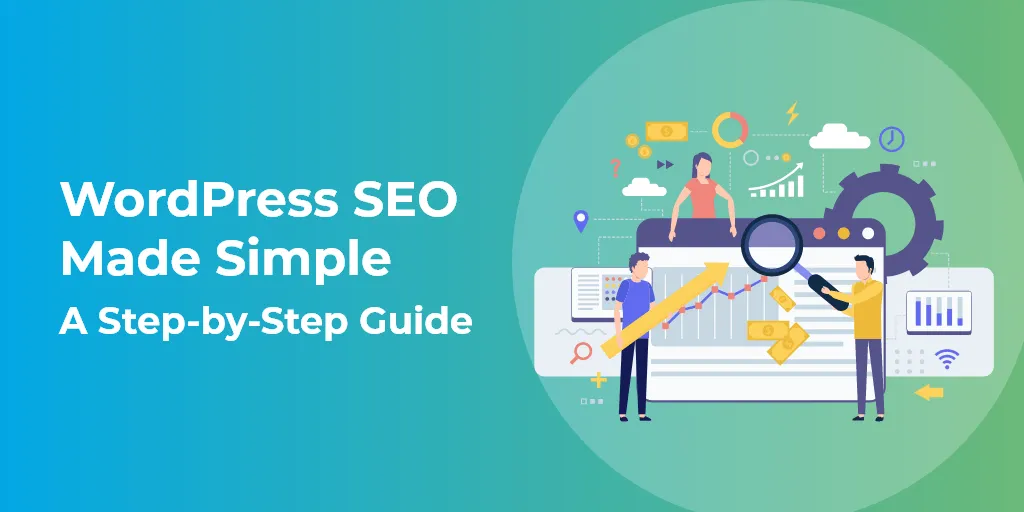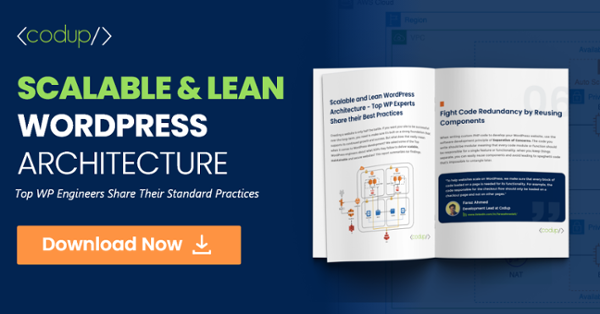WordPress SEO Guide: How To SEO WordPress Sites

SEO will live as long as Google lives. Because as long as your audience keeps searching for your products or services on Google, you’ll need to keep optimizing your site so that it appears on the first page of the search engine results page (SERPs). Even though WordPress is already a good CMS for SEO, it doesn’t mean you don’t have to do anything to optimize your site and bring it up on the search pages. In this WordPress SEO guide, we’ve listed 13 actionable and valuable ways on how to SEO WordPress sites that will get your site ranking in a few months.
WordPress SEO Guide: Tips to Boost Your Site Rankings
We use these SEO techniques ourselves to drive organic traffic to our site. We also make sure we use these SEO techniques in our WordPress web development services.
How to SEO WordPress Tip #1: Research Your Keywords
The first and foremost task in your SEO endeavor is to research keywords you want your site to rank for. You need to go all out with competitor research when coming up with your own list of keywords.
Use a tool like AHREFS for your keyword research. You can put your competitors’ site URLS in AHREFS to find out which keywords your competitors are ranking for.
Apart from that, you can do your own research by getting into your buyer persona’s mindset and thinking about what your prospects would likely search for.
Make a list of all those keywords you can think of and then put them in the AHREFS keyword research tool to find out how many monthly searches those keywords are getting.
You can also use the free Keyword Planner tool by Google Adwords if you don’t want to invest in a premium tool like AHREFS – though it’s highly recommended that you do.
No matter what tool you use, you need to keep an eye on two metrics when doing your keyword research – average monthly searches and competition.
You should be aiming for keywords with a high number of monthly searches but low competition so that your SEO efforts pay off quicker.
Try to find long-tail keywords, which have usually low to medium monthly searches and low competition.
With long-tail keywords, you can get ranked easily and start getting organic traffic faster.
AnswerThePublic.com is a good tool for researching long-tail keywords.
WordPress SEO Tip #2 Optimize Your Permalinks
Think of your permalink, which is basically the URL of your site pages, as your physical address that users and site crawlers use to find your site.
You need to optimize your permalinks to improve the user experience, allow people to easily remember them, and give a signal to Google’s crawlers about what kind of content they can expect on the page.
Here are some permalink SEO tips to optimize your site for SEO:
Domain Name
Try to get a domain name with the keyword in it. Provided that you maintain a high-quality site, having an exact match keyword in your domain will immediately give you a head start in SERP rankings.
Permalink Structure
Use a friendly structure for your permalinks. One good thing about WordPress is that it lets you customize your permalink structure so you can optimize them and make sure they’re SEO friendly.
What do we mean by a friendly structure?
Well, if the URL makes it easy for you to understand the specific location of the page in the overall site structure, it means it’s a friendly URL structure.
Consider the two examples here and see which one makes it easy for you to understand the site structure.
In the second example, it’s clear you’ll be navigating to the company’s blog and on a post, which has information about B2B vs B2C eCommerce.
The first example, on the other hand, doesn’t tell you anything about the page you’ll visit if you click on the link.
If the URL structure doesn’t look friendly to you, it won’t be a good indicator for the site crawler as well, and will probably hurt your SERP rankings.
Short Permalinks
Another SEO tip for WordPress is to keep your permalinks as short as you can. The shorter they are, the easier it is to remember them – another good indicator for search engine crawlers.
One thing you can do to shorten your permalinks is dropping the WWW from the beginning.
To do that, go to the Settings option on WordPress and navigate to General Settings.
In WordPress Address URL and Site URL fields, enter your site URL without the WWW.
Besides this, you need to shorten the URL for every post and page you publish on your site. WordPress usually puts your entire page title in the permalink. But you can customize it and shorten it by removing all the stop words.
Include the Keyword in the Permalink
Try to include the keyword in the permalink for a good SEO benefit.
For example, if you’re creating a site for your Travel Company and publishing a page about your budget tours, try to include your main keyword like ‘Winter Budget Tours’ in the permalink.
Your permalink could look something like this:
Travelcompany.co/winter-budget-tours/
Avoid Adding Dates
Adding dates in the URL is a complete no-no.
The logic is simple: your users will see how outdated your posts are and will choose to visit other pages, which they think are more recent.
SEO Tip #3 Use a WordPress SEO Plugin
Yoast SEO is one of the best plugins that we at Codup use as well.
Even the free version is good enough.
When you install the plugin, it takes care of all the on-page SEO for you. Just add keyword in Yoast SEO and it will give you a list of recommendations along with an SEO score of your content.
You can go through their recommendations one by one to improve the SEO score and aim for the green light.
Ultimate SEO Guide Tip #4 Write Well-Optimized Meta Descriptions and Meta Titles
Meta Title is the title of your page that appears on the SERPs while meta description is the small snippet that appears underneath.
WordPress SEO plugins like Yoast let you customize meta descriptions and meta titles to optimize them.
Meta Titles and Meta Descriptions aren’t just important indicators for search engine crawlers, they’re important for your users as well.
The meta title and description are what a user sees first on SERPs and uses to decide whether to click.
That’s why these two pieces of content are so crucial for your organic traffic.
While you should optimize for site crawlers by including your keywords, you should also write compelling copy that grabs attention.
And all this has to be done in the limited character count that is allocated to this space!
Your meta titles should be around 65 characters while meta description has to be under 160 characters. If they’re longer than that, they’ll appear truncated, which isn’t a good user experience.
Key takeaway: Optimize your meta titles and descriptions for both, site crawlers and users in the limited character count provided.
WordPress SEO Tip #5 Include Your Keywords in the Website Copy
Keyword optimization is as relevant today as it was a decade ago. But things have changed.
Google imposes penalties for keyword stuffing. And so, you need to keep your keywords as natural as possible.
The main focus now is on the readability of your content. If your reader or the site crawler feels like you’re shoving keywords down their throats, it isn’t a good indicator for SEO.
But it doesn’t mean you don’t include keywords at all in your content.
The idea is to write the content around the keyword, which will also be your topic, and include the keywords naturally in the content, using different keyword variations.
Try to include the keyword in the first paragraph or in the first 200 words of your copy. This gives a positive indicator to the site crawler that your content is centered around the keyword.
Also, include your main keyword in at least one heading tag like H1 or H2.
SEO Tip #6 Create an XML Sitemap
Not sure what an XML sitemap is?
It sure sounds technical, I know.
But it’s really simple actually. It’s basically a list of your website URLs, mapping out the entire structure of your site, and listing all the pages on your site.
Having an XML sitemap makes it easy for Google to find all your important pages – just like Google Maps makes it easy for you to get to places you haven’t visited before.
While Google won’t have much trouble finding and indexing your site without the XML sitemap, having one just makes the task easier for Google crawlers.
And so, it’s highly recommended that you have one.
And you don’t even have to bust a gut trying to create one on WordPress.
You can literally have a sitemap created with a few clicks by using an SEO plugin like Yoast SEO.
Yoast SEO lets you create an XML sitemap on WordPress with a few clicks.
How to create an XML Sitemap on WordPress with Yoast:
Install the Yoast Plugin and activate it.
On activating, Yoast will add an SEO tab on your WordPress dashboard.
Go to General and then click on the Features tab.
Turn on the XML Sitemaps option on the Features page.
On turning the option on, you’ll see a link for your XML Sitemap.
Just click on the above link and go to your sitemap page, which might look something like this.
Next, copy the last part of the URL of your sitemap page: sitemap_index.xml
You’ll need this when submitting the sitemap to Google.
How to Submit your Sitemap to Google
Now comes the most important part of the whole struggle: submitting your XML sitemap to Google.
For this, you need to connect your WordPress site with Google Search Console.
If you’ve already done that, go to Google Search Console and select your website.
In the left sidebar, navigate to Crawl => Sitemaps.
Then click on the red button at the top right corner that says: Add/Test Sitemap
Now, in the small box that appears, paste the last part of the URL you copied from the sitemap page of your site.
And that’s it!
You’ve done the work.
Sit back and take a deep breath as Google starts crawling your site!
Tip #7 Do Heavy Internal Linking
Search engines look at the number of links a page is receiving to determine its page authority.
While links coming in from external sites are most valuable, internal links are helpful too.
Internal links are basically links coming in from other pages on your own site as opposed to backlinking, which are links coming in from other external sites.
This means internal linking is also easier to implement than getting backlinks from external sites as you can strategically place links across your site yourself.
Whenever you’re adding a new page or post, think of how you can link internally to other pages.
Adding a link is quite simple. Just select the text you want to link to, click on the link option in the taskbar, and paste the URL you want to link to.
WordPress also has a nice feature where it automatically shows you related posts or pages when you highlight some text and click on the link option. And so, you can simply select from the list of related posts instead of searching for the article on your blog and copying the URL from there.
Tip #8 Speed Up Your Site
How is the site speed related to SEO?
Well, think of the search engine crawler as a real visitor on your site. Everything that will improve the user experience of a real visitor will impress the crawler as well.
Keeping that in mind, think of how a slow website can put off your site visitors.
Nobody wants to hang around and wait forever for a site to load.
‘Forever’ is actually an understatement. People have become so impatient that they’ll mercilessly abandon a site if it takes more than 3 seconds to load.
This makes it imperative for you to take every step you can to optimize your site’s speed and increase its loading time.
Here are some ways you can improve your site’s speed:
Check out this comprehensive guide about speeding up your WordPress site.
Tip #9 Optimize Your Images
SEO takes a bit of your time but it’s all worth it when you start seeing the result.
One thing many marketers don’t emphasize enough is on optimizing their images with relevant alt-texts.
Alt-text is really crucial as it helps to optimize your images to improve their SERP rankings as well.
If you run Google search, you’ll notice that it shows you a bunch of images on top before other links.
Times have changed now. People don’t just want to read text when looking for information. They’ll look for graphics and images when searching for information online.
Say I’m searching for a shade of red lipstick by a renowned brand. In that case, I would want to look at the images tab before I click on any text links. And if I find the right image, I might just click through from that image and land on the page where the image is uploaded to buy the product or find more about it.
This is why image optimization has become very important to make sure you’re not missing out on organic traffic that can come through images.
How to Add Alt-tags on Images in WordPress?
It’s very simple to add alt-text on WordPress. When you’re adding an image on WordPress, you’ll see the alt-text field right there.
But even if you miss it, you can go ahead and edit that image to add your alt-text.
Now, comes the most important part.
What kind of alt-text to add on images?
Alt-text is basically the alternative text that loads up in case the image fails to load. This is also the text, which screen readers use to describe the image for visually impaired users.
Just keep true to its real purpose and that’s about it.
Be as descriptive and specific as you can. Make sure the alt-text describes what the image is about.
And lastly, add some keywords in the alt text.
Keep it natural and avoid adding keywords in all the images on your page.
#10 Block Spam Comments
Think of spam comments as a site disease that slowly rots away your site, lowers its reputation, and negatively impacts the user experience.
Spam comments are just gibberish that mean nothing and which amateur SEO guys leave on your site in the hopes of getting backlinks.
And so, you need to be proactive with your comment strategy and make sure no comments end up on the front end of your site without your approval.
Go to WordPress Settings => Discussions and make sure the first checkbox is selected under the option titled ‘Before a comment appears’.
Secondly, use a plugin like Akismet to automatically detect what is spam and add those in the spam section instead of in the moderation queue.
It really takes off half the headache for you.
#11 Post Regular Content
Regular and frequent high-quality content has the same effect on Google as small and frequent meals have on your metabolism.
Well, kind of.
Whenever you post some fresh content that answers the questions people are searching for, it gives an indicator to Google’s indexing machines to index your site.
The more regular and frequent those indicators are, the better it is.
You should not only be posting new, fresh content but also updating old content with relevant information.
#12 Use a WordPress Security Plugin
Last but not the least, use a WordPress security plugin and other security best practices to keep your site secure from malicious attacks.
Read this comprehensive guide about WordPress security to find out all the security best practices you should be following to tighten up your defenses.
Why is security important for SEO?
Well, think of the same analogy of a site crawler vs a human visitor.
Everything that appeals to a human will be a positive indicator for the crawler and everything that alerts a human and makes him abandon your site will give a negative indicator to the crawler as well.
It’s 2020 – the lines between humans and robots have become dim!
Finding these tips overwhelming?
Having the tips and rules at your disposal doesn’t always mean you can always do it right – especially if you are not an expert at doing it. Having a website up and running requires technical knowledge, and the same goes for SEO.
The above-mentioned tips can surely help you do justice to your WordPress site, but it can be difficult if you don’t know the ins and outs of how SEO works. This is where having a trustable SEO service that follows the best SEO practices is an option one cannot ignore.
Back to Your Site
WordPress is a good CMS for SEO but that doesn’t mean you don’t need to slave away with some on-page and off-page SEO to get your SERP rankings up.
This article listed all of the on-page SEO you should be doing to improve your site’s rankings and the user experience as well.
In the end, remember that you need to be patient and consistent with all your SEO efforts. Just keep doing the right things and you’ll eventually see the light of day!




